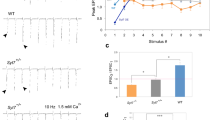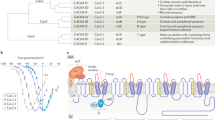Abstract
PRESYNAPTIC modulation of action potential duration may regu-late synaptic transmission in both vertebrates1 and invertebrates2-4. Such synaptic plasticity is brought about by modifications to membrane currents at presynaptic release sites, which, in turn, lead to changes in the concentration of cytosolic calcium available for mediating transmitter release. The 'primitive' neuromuscular junction of the jellyfish Polyorchis penicillatus is a useful model of presynaptic modulation. In this study, we show that the durations of action potentials in the motor neurons of this jellyfish are negatively correlated with the amplitude of excitatory junctional potentials. We present data from in vitro voltage-clamp experiments showing that short duration voltage spikes, which elicit large excitatory junctional potentials in vivo, produce larger and briefer calcium currents than do long duration action potentials, which elicit small excitatory junctional potentials.
This is a preview of subscription content, access via your institution
Access options
Subscribe to this journal
Receive 51 print issues and online access
$199.00 per year
only $3.90 per issue
Buy this article
- Purchase on Springer Link
- Instant access to full article PDF
Prices may be subject to local taxes which are calculated during checkout
Similar content being viewed by others
References
Lin, J. W. & Faber, D. S. J. Neurosci. 8, 1313–1325 (1988).
Kusano, K., Livengood, D. R. & Werman, R. Science 155, 1257–1258 (1967).
Hochner, B., Klein, M., Schacher, S. & Kandel, E. R. Proc. natn. Acad. Sci. U.S.A. 83, 8410–8414 (1986).
Fuchs, P. A., Henderson, L. P. & Nicholls, J. G. J. Physiol. (Lond.) 323, 195–240 (1982).
Spencer, A. N. J. exp. Biol. 93, 33–50 (1981).
Spencer, A. N. J. comp. Physiol. 148, 353–363 (1982).
Augustine, G. J., Charlton, M. P. & Smith, S. J. A. Rev. Neurosci. 10, 633–693 (1987).
Przysiezniak, J. & Spencer, A. N. J. exp. Biol. 142, 97–113 (1989).
Spencer, A. N. J. Neurobiol. 10, 95–117 (1979).
Zucker, R. S. & Lando, L. Science 231, 574–578 (1986).
Author information
Authors and Affiliations
Rights and permissions
About this article
Cite this article
Spencer, A., Przysiezniak, J., Acosta-Urquidi, J. et al. Presynaptic spike broadening reduces junctional potential amplitude. Nature 340, 636–638 (1989). https://doi.org/10.1038/340636a0
Received:
Accepted:
Issue Date:
DOI: https://doi.org/10.1038/340636a0
This article is cited by
-
Two-pore domain potassium channels enable action potential generation in the absence of voltage-gated potassium channels
Pflügers Archiv - European Journal of Physiology (2015)
-
Action potential shape change in an electrically coupled network during propagation: a computer simulation
Invertebrate Neuroscience (2008)
-
Regulation of synaptic timing in the olfactory bulb by an A-type potassium current
Nature Neuroscience (1999)
-
Reduced transmitter release conferred by mutations in theslowpoke-encoded Ca2+-activated K+ channel gene ofDrosophila
Invertebrate Neuroscience (1996)
-
Broad minded on narrow spikes
Nature (1989)
Comments
By submitting a comment you agree to abide by our Terms and Community Guidelines. If you find something abusive or that does not comply with our terms or guidelines please flag it as inappropriate.



